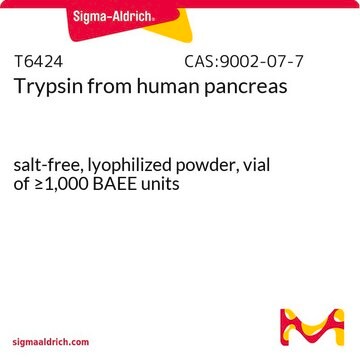Recommended Products
form
powder
specific activity
~1500 U/mg
mol wt
23.8 kDa
foreign activity
chymotrypsin ≤0.1%
storage temp.
2-8°C
Looking for similar products? Visit Product Comparison Guide
Application
For trypsin digestion of peptides, use a ratio of about 1:100 to 1:20 for trypsin:peptide. The typical use for this product is in removing adherent cells from a culture surface. The concentration of trypsin necessary to dislodge cells from their substrate is dependent primarily on the cell type and the age of the culture. Trypsins have also been used for the re-suspension of cells during cell culture, in proteomics research for digestion of proteins and in various in-gel digestionsns†. Additional applications include assessing crystallization by membrane-based techniques and in a study to determine that protein folding rates and yields can be limited by the presence of kinetic traps.
Biochem/physiol Actions
Trypsin cleaves peptides on the C-terminal side of lysine and arginine residues. The rate of hydrolysis of this reaction is slowed if an acidic residue is on either side of the cleavage site and hydrolysis is stopped if a proline residue is on the carboxyl side of the cleavage site. The optimal pH for trypsin activity is 7-9. Trypsin can also act to cleave ester and amide linkages of synthetic derivatives of amino acids. EDTA is added to trypsin solutions as a chelating agent that neutralizes calcium and magnesium ions that obscure the peptide bonds on which trypsin acts. Removing these ions increases the enzymatic activity.
Serine protease inhibitors, including DFP, TLCK, APMSF, AEBSEF, and aprotinin, amongst others, will inhibit Trypsin.
Serine protease inhibitors, including DFP, TLCK, APMSF, AEBSEF, and aprotinin, amongst others, will inhibit Trypsin.
Unit Definition
1 U corresponds to the amount of enzyme which increases the absorbance at 253 nm by 0.001 per minute at pH 7.6 and 25°C (N-benzoyl-L-arginine ethyl ester, Cat. No. 12880, as substrate)
One BAEE unit will produce a ΔA253 of 0.001 per min at pH 7.6 at 25° C using BAEE as substrate. One BTEE unit = 320 ATEE units. Reaction volume = 3.2 mL (1 cm light path).
Other Notes
Sales restrictions may apply
Signal Word
Danger
Hazard Statements
Precautionary Statements
Hazard Classifications
Eye Irrit. 2 - Resp. Sens. 1 - Skin Irrit. 2 - STOT SE 3
Target Organs
Respiratory system
Storage Class Code
11 - Combustible Solids
WGK
WGK 1
Personal Protective Equipment
dust mask type N95 (US), Eyeshields, Gloves
Certificates of Analysis (COA)
Search for Certificates of Analysis (COA) by entering the products Lot/Batch Number. Lot and Batch Numbers can be found on a product’s label following the words ‘Lot’ or ‘Batch’.
Already Own This Product?
Find documentation for the products that you have recently purchased in the Document Library.
Customers Also Viewed
Peter Halasz et al.
Journal of virology, 82(1), 148-160 (2007-10-19)
Changes in the interactions between intestinal cells and their surrounding environment during virus infection have not been well documented. The growth and survival of intestinal epithelial cells, the main targets of rotavirus infection, are largely dependent on the interaction of
R J Read et al.
Biochemistry, 23(26), 6570-6575 (1984-12-18)
The X-ray crystal structure of Streptomyces griseus trypsin has been solved and refined at 1.7-A resolution. The structure of this protein had been predicted in two models on the basis of its expected homology to structures of bovine trypsin and
Norelle L Daly et al.
The Journal of biological chemistry, 288(50), 36141-36148 (2013-10-31)
MCoTI-II is a head-to-tail cyclic peptide with potent trypsin inhibitory activity and, on the basis of its exceptional proteolytic stability, is a valuable template for the design of novel drug leads. Insights into inhibitor dynamics and interactions with biological targets
Bernard A Fang et al.
Biochimica et biophysica acta, 1845(1), 1-19 (2013-11-26)
N-myc down-regulated gene 1 (NDRG1) is a known metastasis suppressor in multiple cancers, being also involved in embryogenesis and development, cell growth and differentiation, lipid biosynthesis and myelination, stress responses and immunity. In addition to its primary role as a
Fikadu G Tafesse et al.
Proceedings of the National Academy of Sciences of the United States of America, 110(16), 6406-6411 (2013-04-12)
Cells genetically deficient in sphingomyelin synthase-1 (SGMS1) or blocked in their synthesis pharmacologically through exposure to a serine palmitoyltransferase inhibitor (myriocin) show strongly reduced surface display of influenza virus glycoproteins hemagglutinin (HA) and neuraminidase (NA). The transport of HA to
Our team of scientists has experience in all areas of research including Life Science, Material Science, Chemical Synthesis, Chromatography, Analytical and many others.
Contact Technical Service









